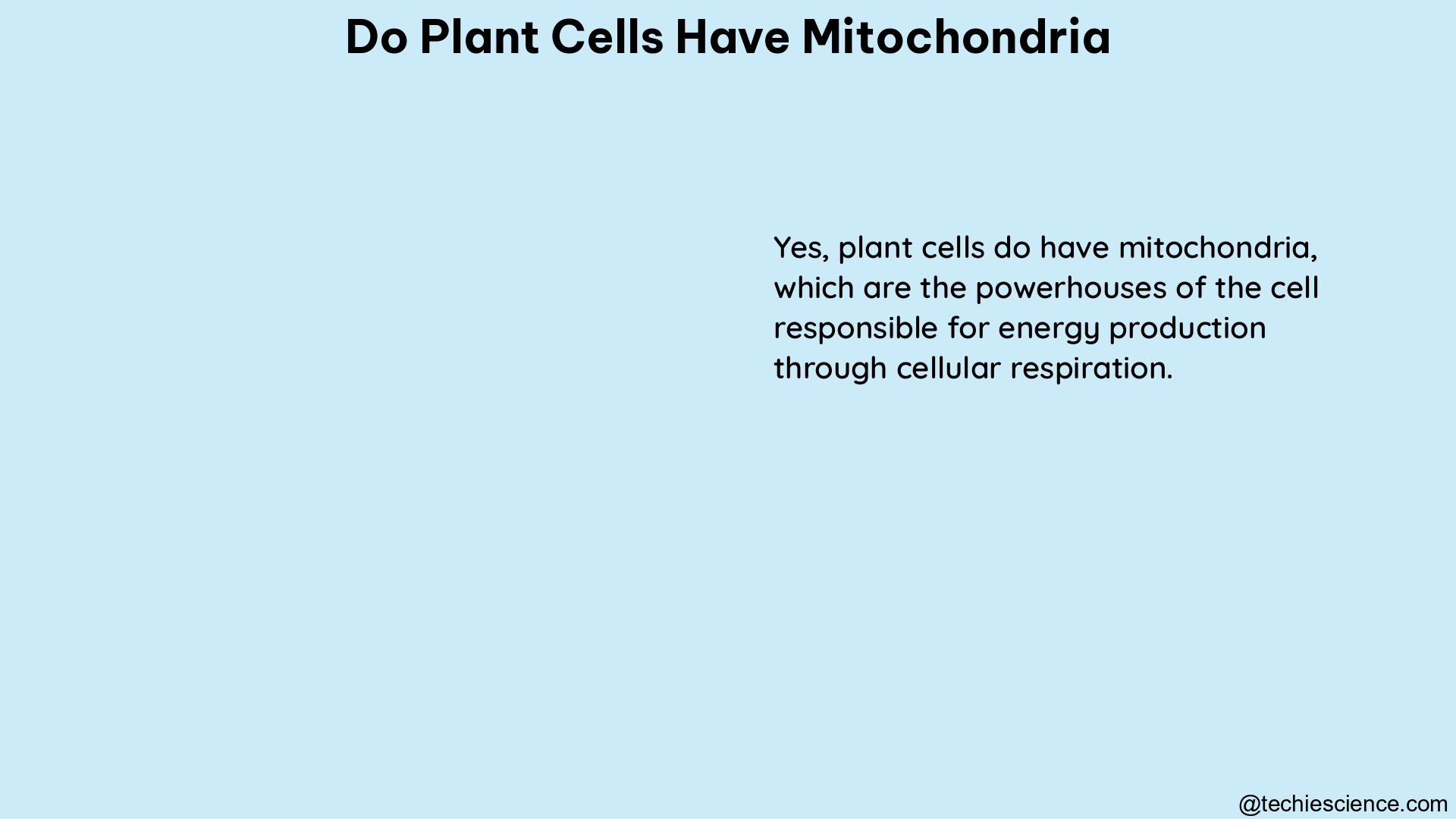Plant cells do contain mitochondria, which are essential organelles responsible for energy production and various cellular functions. Mitochondria play a crucial role in generating ATP (adenosine triphosphate) through cellular respiration and photosynthesis, providing the necessary energy for plant cells to thrive.
The Presence of Mitochondria in Plant Cells
Mitochondria are found in the cytosol of plant cells, distributed throughout the cell’s interior. These organelles are responsible for breaking down sugars, such as glucose, to produce ATP, which serves as the primary energy currency for the cell.
In plant cells, the process of energy production occurs through both photosynthesis and cellular respiration. During the day, plant cells utilize mitochondria to generate energy through photosynthesis, while at night, they rely on cellular respiration to produce energy.
Structural Differences in Plant and Animal Mitochondria

Interestingly, the structure of mitochondria in plant cells differs from those found in animal cells. In plant cells, mitochondria are typically fragmented, existing as individual organelles that interact through physical colocalization. This is in contrast to animal cells, where mitochondria form large networks and are often represented as edges and branch points as nodes.
In plant cells, mitochondria are represented as nodes, and the colocalization events are represented as edges, which is more analogous to the representation of social networks in other systems.
Quantifying Mitochondrial Characteristics in Plant Cells
The number, size, and shape of mitochondria in plant cells can be quantified using experimental characterization and mechanistic modeling. For instance, in Arabidopsis hypocotyl cells, researchers have been able to measure the basic size, shape, and number of mitochondria and use these parameters to parameterize the model.
Mitochondrial Size and Shape in Arabidopsis Hypocotyl Cells
- Size: The average size of mitochondria in Arabidopsis hypocotyl cells is approximately 0.5-2 μm in diameter.
- Shape: Mitochondria in Arabidopsis hypocotyl cells can exhibit a variety of shapes, including spherical, elliptical, and elongated forms.
Mitochondrial Number in Arabidopsis Hypocotyl Cells
- Number: The number of mitochondria in Arabidopsis hypocotyl cells can vary, with an average of 50-100 mitochondria per cell.
By quantifying these mitochondrial characteristics, researchers can gain a deeper understanding of their function and behavior within the plant cell.
Mitochondrial Dynamics in Plant Cells
Mitochondria in plant cells are not static; they exhibit dynamic behavior, including fusion, fission, and movement within the cell. These dynamic processes are essential for maintaining the overall health and function of the mitochondrial network.
Mitochondrial Fusion and Fission
- Fusion: Mitochondria can fuse with each other, allowing for the exchange of genetic material and the sharing of resources.
- Fission: Mitochondria can also divide, or undergo fission, to create new mitochondria within the cell.
Mitochondrial Movement
Mitochondria in plant cells can move within the cytosol, often along the cytoskeleton. This movement is crucial for distributing mitochondria to areas of the cell that have high energy demands, such as actively growing regions or sites of cellular respiration.
Mitochondrial Genome and Inheritance
Plant mitochondria possess their own genome, which is distinct from the nuclear genome. The mitochondrial genome in plants is typically larger and more complex than the mitochondrial genomes found in animals.
Mitochondrial Genome Characteristics
- Size: The mitochondrial genome in plants can range from 200 kilobases (kb) to over 11 megabases (Mb) in size, depending on the plant species.
- Complexity: The plant mitochondrial genome can contain a variety of genetic elements, including protein-coding genes, ribosomal RNA genes, and a large number of introns.
Mitochondria in plant cells are typically inherited maternally, meaning that the mitochondrial genome is passed down from the female parent to the offspring.
Mitochondrial Functions in Plant Cells
In addition to their role in energy production, mitochondria in plant cells perform a variety of other essential functions:
-
Cellular Respiration: Mitochondria are the primary site of cellular respiration, where they convert the energy stored in organic molecules (such as glucose) into ATP, the universal energy currency of the cell.
-
Photosynthesis: During the day, plant cells utilize mitochondria to generate energy through photosynthesis, which is the process of converting light energy into chemical energy in the form of ATP and NADPH.
-
Calcium Signaling: Mitochondria can act as calcium buffers, sequestering and releasing calcium ions, which are important for various signaling pathways within the plant cell.
-
Apoptosis: Mitochondria play a role in the process of programmed cell death, or apoptosis, which is essential for plant development and response to environmental stresses.
-
Thermogenesis: In some plant species, such as the skunk cabbage (Symplocarpus foetidus), mitochondria are involved in the production of heat, which helps the plant maintain a warm temperature and attract pollinators.
Conclusion
In summary, plant cells do contain mitochondria, which are essential organelles responsible for energy production and various cellular functions. Mitochondria in plant cells exhibit structural differences compared to animal cells, and their number, size, and shape can be quantified using experimental characterization and mechanistic modeling. Mitochondria in plant cells also exhibit dynamic behavior, including fusion, fission, and movement, which are crucial for maintaining the overall health and function of the mitochondrial network. Additionally, mitochondria in plant cells perform a variety of essential functions, including cellular respiration, photosynthesis, calcium signaling, apoptosis, and thermogenesis.
References:
- Mitochondrial Dynamics in Plant Cells
- Mitochondrial Genome and Inheritance in Plants
- Mitochondrial Functions in Plant Cells
- Quantifying Mitochondrial Characteristics in Arabidopsis Hypocotyl Cells
- Structural Differences in Plant and Animal Mitochondria
Hi, I am Sayantani Mishra, a science enthusiast trying to cope with the pace of scientific developments with a master’s degree in Biotechnology.